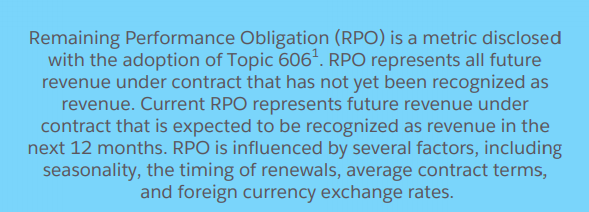I'll try my best to explain these concepts:
- Bookings
- Billings
- Revenue
- ARR
- DBNER
- DBGRR
- DBNRR
- Deferred Revenue
- RPO
[THREAD]
This is usually synonymous with total contract value (TCV).
Let's say a customer commits to an annual contract of $24,000 at the beginning of the year. Boom, that's $24k in bookings.
The difference between billings & bookings is payment terms.
Using the same example, if the customer couldn't pay everything upfront, your sales rep allows them to pay half upfront, then the other half 6 months later.
January billings: $12k
July billings: $12k
Revenue can only be recognized when a service is performed.
In our example, even if the customer pays all $24k upfront, that doesn't all go to sales.
For a normal SaaS business, revenue is typically recognized ratably. So quarterly revenue would be $6k (24/12 * 3)
For on-premise software, accounting standard 606 may require companies to recognize revenue differently.
Here is a prime example:
The difference between revenue & billings is contract length.
If the customer pays for one month at a time ($2k), billings & revenue would be the same.
Also, if the customer paid all $24k upfront, bookings and billings in January would be the same.
Jan 1: $2k MRR = revenue
Jan 15: upgrades to $5k monthly plan
January MRR = $5k
January revenue = $1k (half month) + $2.5k (half month) = $3.5k
This is one type of discrepancy between ARR and revenue, another being the Alteryx example.
The highest this can be is 100%.
Typically, it's the percentage of ARR (or revenue) that is not lost to churn. It doesn't include expansions (upgrades).
This is similar to DBGRR but includes expansions. You can also think of it as the DBNER but inclusive of churn.
I think this is the most important of the three since it includes everything.
The expansion/retention stuff may be measured on a TTM (twelve month trailing) basis.
So the DBNER could be very high in one quarter which lifts the TTM number or the converse of this.
DBNER and DBNRR can be well over 100%.
Deferred revenue is actually a liability b/c the company still has to perform a service on money that's been collected.
If a customer pays $24k for an annual contract upfront:
Billings: $24k
Q1 revenue: $6k
Deferred revenue: $18k (24-6)
We can now see that billings can actually be calculated as revenue + changes in deferred revenue.
This is a little more rare but unbilled receivables are when the company has provided the service but hasn't billed the customer.
In that case, billings would be calculated like this:
revenue + change in deferred revenue - change in unbilled receivables.
You can begin to see that there is potential for a lot of noise in this number depending on duration/payment terms.
This can be super confusing! Hopefully this gives some more context.
One important thing is to read the footnotes! Some companies will report things a little differently and that can actually matter.






